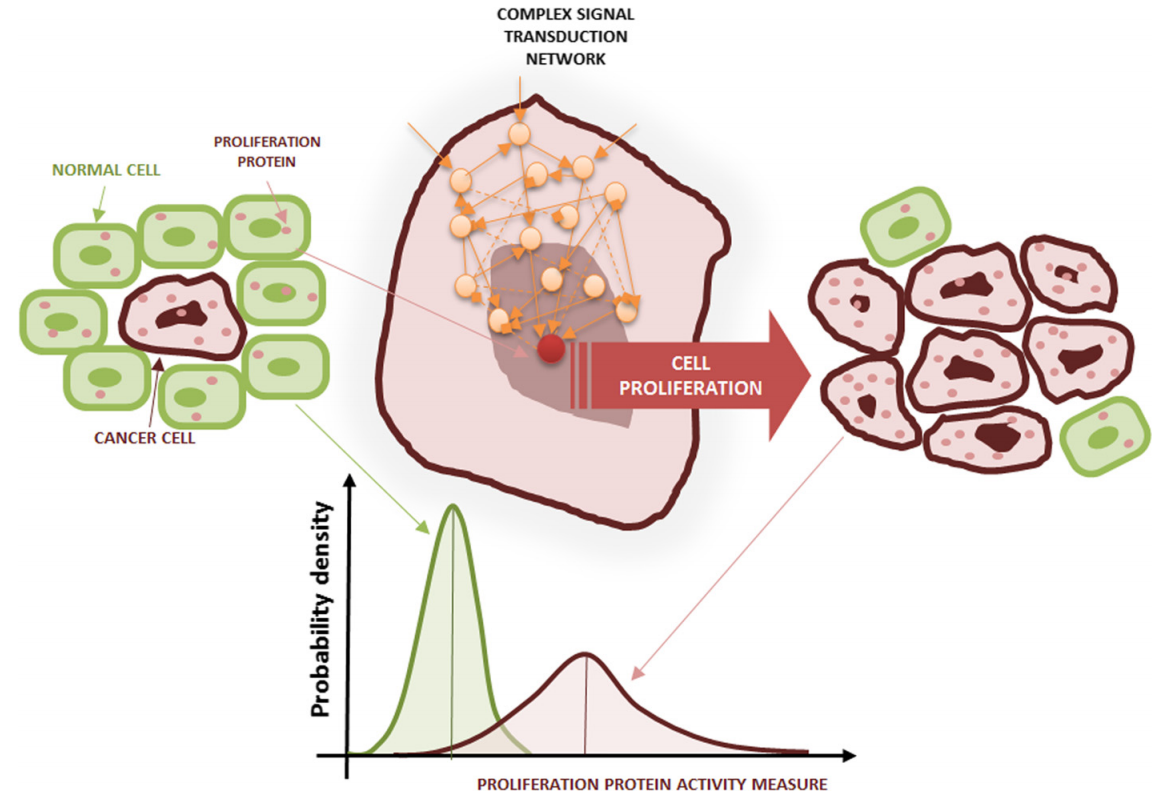Cell proliferation is defined as the process that leads to an increase in the number of cells and the balance between cell divisions and cell loss. Cell proliferation plays an important role in regular tissue and cellular homeostasis for proper growth, development and maintenance of the organism. Moreover, abnormal cell proliferation is associated with different diseases, such as cancer. The cell proliferation assays can be used for pharmaceutical drug discovery and diagnostic purposes.
 Figure 1. Cancer cell proliferation (Bianconi F, et al., 2015)
Figure 1. Cancer cell proliferation (Bianconi F, et al., 2015)
Different assays are available to examine the viability of cells and measure the number of cells, or change in rate of division of cells. The cell proliferation assays can be classified into in vitro and in vivo assays. The in vitro cell proliferation enable to determine the cytotoxicity and apoptosis; and in vivo cell proliferation aims to study cell proliferation episode sites and understand the developmental stages of various animals/organs and the pathology of cancerous tissues.
There are many assays can be used for cell proliferation assays which has been classified into four groups as listed below, including rate of deoxyribonucleic acid (DNA) synthesis, metabolic activity of cells, antigens associated with cell proliferation, and variations in adenosine triphosphate (ATP) concentration. At Creative Bioarray, we can provide various methods for cell proliferation, including but limited to the following table.
| Method | Description |
|---|---|
| MTS Cell Proliferation Assay | MTS, a type of tetrazolium salt, can be used to detect cell proliferation by measuring metabolic activity of a population of cells. MTS assay is based on the NAD(P)H dependent dehydrogenase enzymes in metabolically active cells to reduce MTS into a colored formazan product that is soluble in cell culture media. |
| MTT Cell Proliferation Assay | MTT assay, a colorimetric assay for assessing cell metabolic activity, can be used to measure cell proliferation rate. This method is based on the cellular mitochondrial dehydrogenase enzymes in viable cells, which can reduce the yellow water-soluble substrate MTT into a dark purple water-insoluble formazan product. The darker the solution, the greater the number of viable and metabolically active cells. |
| Fluorescent Cell Proliferation Assay | Fluorescent cell proliferation assays can be widely used in the quantification of cell proliferation by measuring the intensity of fluorescent signal. In this method, the non-fluorescent reagent can be converted into a bright red fluorescent form by the metabolically active live cells. |
| BrdU Cell Proliferation Assay | Bromodeoxyuridine (BrdU), a type of halogenated nucleotide, can label DNA in viable cells. BrdU can replace thymidine and incorporate into the synthesized DNA of actively dividing cells during the cell cycle. And BrdU incorporation can be assessed by some methods, such as colorimetric ELISA. |
| Cell Proliferation Assay with Immunoassay | Proliferating cells can express some specific proteins that cannot be expressed in non-proliferating cells, such as PCNA, Ki67, and MCM-2. Specific primary antibodies can identify and combine the antigens that are specifically expressed in the process of cell proliferation. |
| Cell Proliferation Assay via DNA Synthesis | DNA synthesis is a high-accuracy and high-reliability method to study cell proliferation. To measure new DNA synthesis, a labeled nucleotide is incorporated into the genomic DNA and the labeled nucleoside can be detected with a reporter. |
At Creative Bioarray, a committed team of experienced scientists will work closely with you to bring responsive and personalized services to provide high-quality service. With years of experience, Creative Bioarray provides reliable cell proliferation assays by various methods. Our ordering procedure is as follows. If you have any questions or specific requirements, please feel free to contact us.

References:
1. Yadav K, et al. Cell proliferation assays. eLS. John Wiley & Sons Ltd: Chichester. 2014,08.
2. Bianconi F, et al. Conditional robustness analysis for fragility discovery and target identification in biochemical networks and in cancer systems biology. BMC systems biology, 2015, 9(1): 70.
Online Inquiry